Phillip and I had made plans to go and climb a route in Huntington Ravine Saturday morning. We were thinking of either O’Dell’s Gully or Yale Gully. This would be our first time successfully climbing ice in the ravine as well.
The night before, I parked my truck in front of his apartment. It would make the 4 a.m start more bearable for both of us. Keep in mind we’re used to sleeping at midnight or 1 a.m.
After getting four hours of sleep, I woke up to a loud thumping. My alarm was beeping, and Phillip was knocking at the door. It was time to leave, and I slept through my alarm. Fortunately, I packed the night before. I put my pants on, grabbed my phone, wallet, keys and backpack; and then stepped out. We’d be using his Prius. With my truck getting 10 MPG and his vehicle getting 40 MPG, it was a no-brainer.
We drove north, driving 80 mph on empty I-93. After the interstate, an hour of mountain roads brought us to Pinkham Notch. We parked and then brought our gear to the visitor center’s packing room. While I think the infrastructure here is too much, that packing room is useful. We divvied up gear in a heated room, rather than in the single-digit temperatures outside.
The weather was cloudy and moderately cold — perfect conditions for ice climbing. It was a wet winter with variable temperatures though. There’s a chance some ice might not be in great shape.
We started to hike up on the wide Tuckerman Ravine trail. It receives plenty of winter traffic and the approach was fast on the highway-like trail.
Most of the winter users here are backcountry skiers who ride Tuckerman Ravine or the Sherburne Trail; ice climbers going to Huntington ravine; Mountaineers going to the summit via the Lion’s Head trail; and hikers going to “Hojo’s.” There were people out and about, but it was more relaxed here than summer. Winter is a more pleasant time to be on the peak, and is far more interesting.
We leapfrogged with a pair of ice climbers on the approach, and passed by a few hiking groups. Some skiers passed by us too. All in all, it was a moderately trafficked day.
We observed something odd: Almost every group hiking to the top via Lion’s Head had an excessive number of snow pickets with them. We weren’t sure why. Maybe snow anchor practice? Maybe they’re all guided? Who knows.
At the turn-off to Huntington Ravine fire road, we passed a guided group of about 6 people. They planned to climb South Gully in Huntington Ravine. It’s a 1,000-foot snow climb on a roughly 40-degree slope. The gullies here are similar to other climbs on other peaks, and makes a great training ground. They also had a million pickets with them, but being a more-cautious guided group it made sense.
We followed the Huntington Ravine fire road until the intersection with the Huntington Ravine Trail. The fire road had one dicey creek crossing with running water and a crumbling snow bridge. Phillip opted to cross the creek by doing some ice-rock-hopping. I crossed the snow bridge, gripping onto tree trunks in case it broke.
We crossed treeline and arrived at the bottom of the boulder field, called “The Fan.” Some scrambling later had us behind the customary “racking-up” rock. It’s a boulder that blocks the wind, and has a flat snow patch beneath it. Here, we put on our harnesses and climbing gear. We also switched our trekking poles for ice tools.
We could see the entire ravine. Every route was fat except for Damnation Gully. While that was climbable, it had some thin ice and mixed sections. We opted to go for O’Dell’s gully, which had thick bright-blue ice.
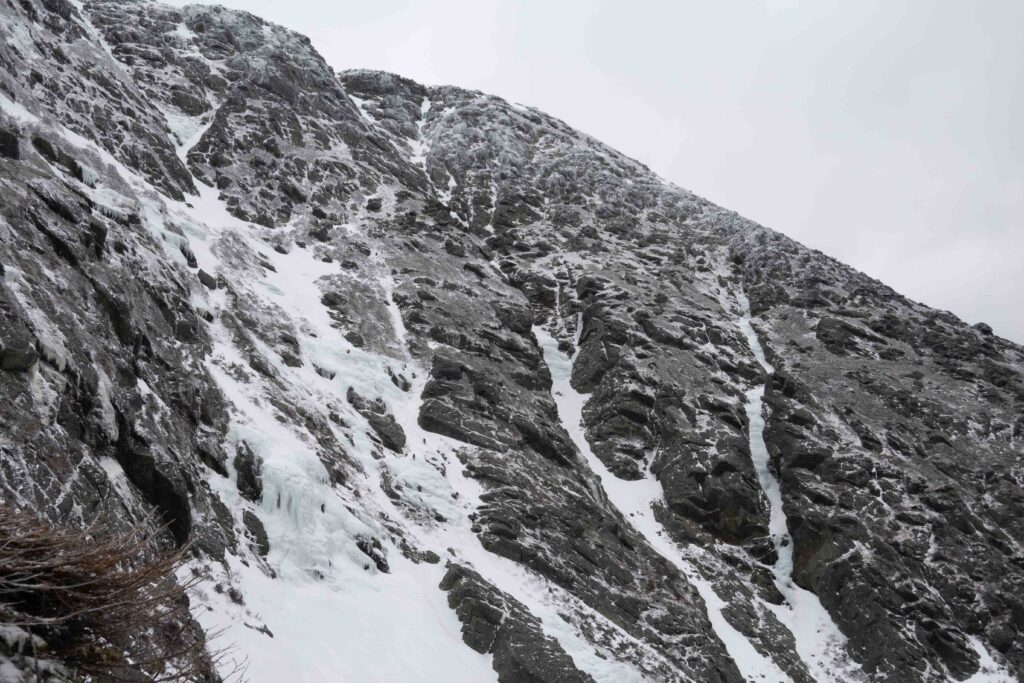
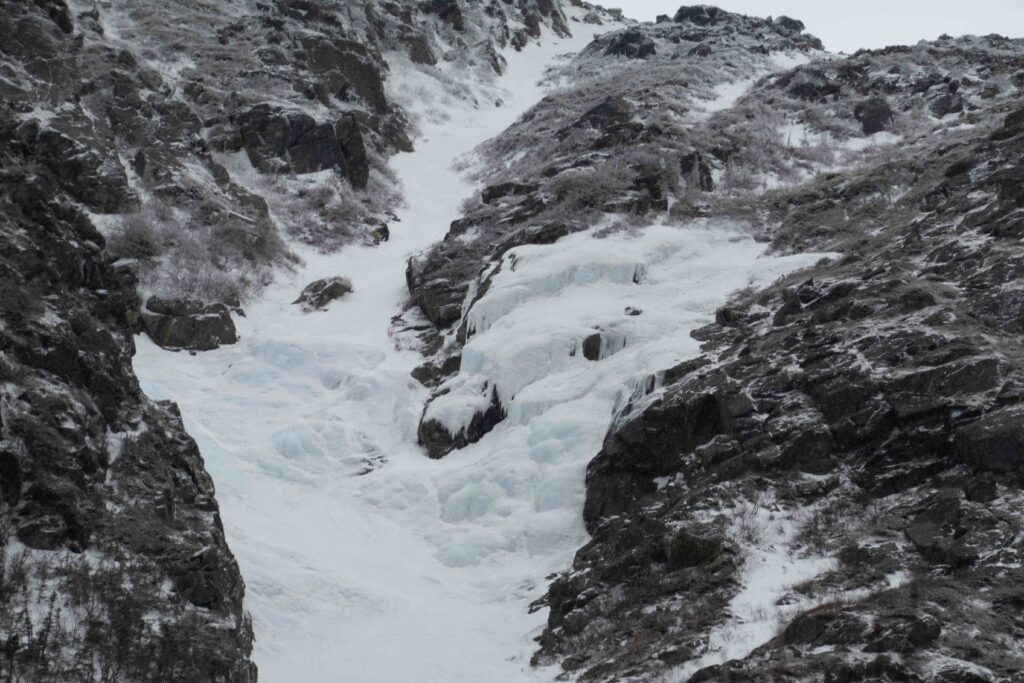
We cramponed up steep snow towards Pinnacle Buttress. It’s a rock ridge that separates Central and Pinnacle Gully from O’Dell’s Gully. It’s also an alpine rock route in summer. We went climber’s left of the buttress and climbed up steeper snow in O’Dell’s until the start of the ice.
There were a few options here. To the left was low-angle ice which continued further up the gully. There was already a group here. To the right was a series of steep cascades and bulges. It looked like a fun climb, and seemed like it was part of O’Dell’s gully as well.
I planned to lead it, and it would be my first ice lead in a while. It was hard to tell the grade given the undulations in the ice, but I guessed WI2+/WI3. Because of the low grade, I only racked a handful of ice screws with me.
I started leading. The climb started strong with several feet of steep climbing before a good rest. But from here, it got steeper. It was more than what I wanted to lead in the alpine on that day. Of course, on ice, you never fall on lead. I never expected to, but I still placed screws more often than I planned. Call it psychological.
The crux of the climb was 10 feet of near-vertical climbing before mantling over a bulge, with a few stemming moves. I placed a screw underneath and started climbing. These moves were fun and athletic, but the ice wasn’t as good as the sections below. It was exceptionally “dinner-platey.” It took time to get good sticks. I was a little pumped. After mantling the bulge, I placed a screw and took on it for a rest.
After that, a rising traverse with fun exposure brought me higher up. But now, I only had two screws left. The next placement would have to be the belay. I noticed the ice got a little worse as I got higher. So, I built a hanging belay in a not-so-great spot. I didn’t know how run-out it would become and I couldn’t see the ice above.
I finished setting up the belay and brought up Phillip. I also snapped some photos. I got some good action shots at an interesting perspective.
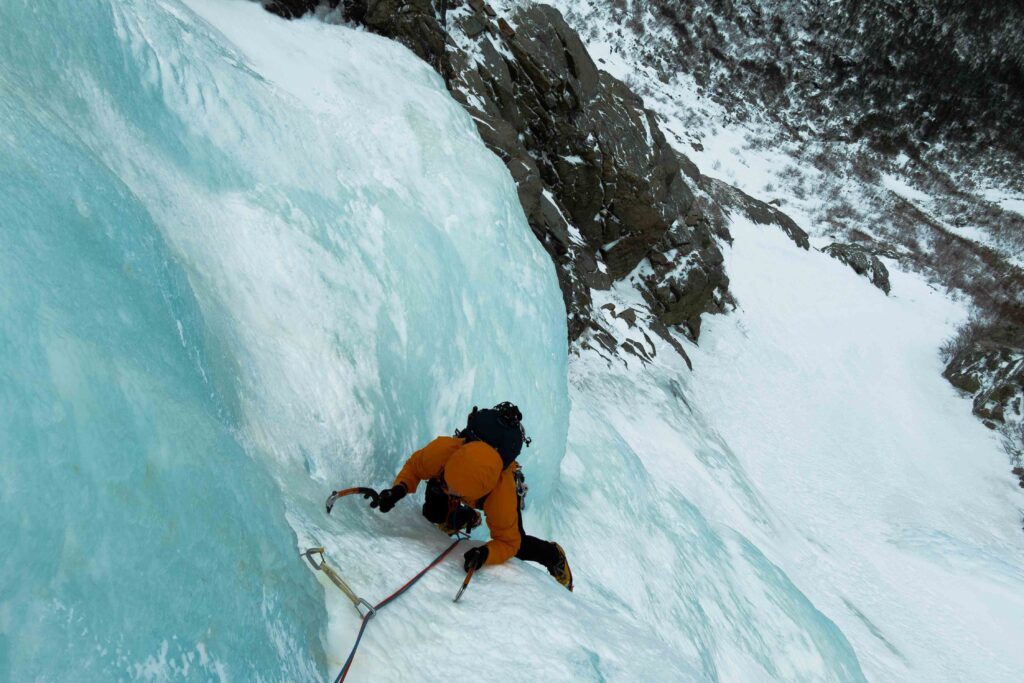
Phillip arrived at my hanging belay. He awkwardly passed me, with his crampons inches away from my face. I’m glad they didn’t blow. And maybe I shouldn’t have built such a bad belay.
I belayed him up as he led this next section. From where I built the stance, I couldn’t see the rest of the route. Turns out the belay was in the fall-line, which I learned as falling ice chunks slammed into my helmet. As he climbed higher up, even more ice would fall — the ice quality was getting worse.
He built another belay and then brought me up. The climb eased in angle, but worsened in ice quality. It was still climbable, just annoying.
As I followed, he stopped me via radio when I was 40 feet below him. He said that he couldn’t see a good way up and that the ice was bad where he was. It looked like tricky mixed climbing from his location. After that, who knows what it would be.
We discussed and decided to rappel the route rather than go higher up into tricky and unknown terrain. There was a convenient rappel anchor where I was. Someone else must have bailed from here, or just run laps. It was bomber too. There were two rap rings around two fresh pieces of cord, connected to two non-rusted pitons and a nut. It doesn’t get any better than that.
He thought of down-climbing the ice on belay, but it wasn’t great quality. He sacrificed an ice screw and I lowered him to the rappel anchor.
From here, we had a spectacular perspective on the main part of O’Dell’s Gully. Some climbers were ascending the bluest ice I’d ever seen. I took some photos from this unreal perspective.
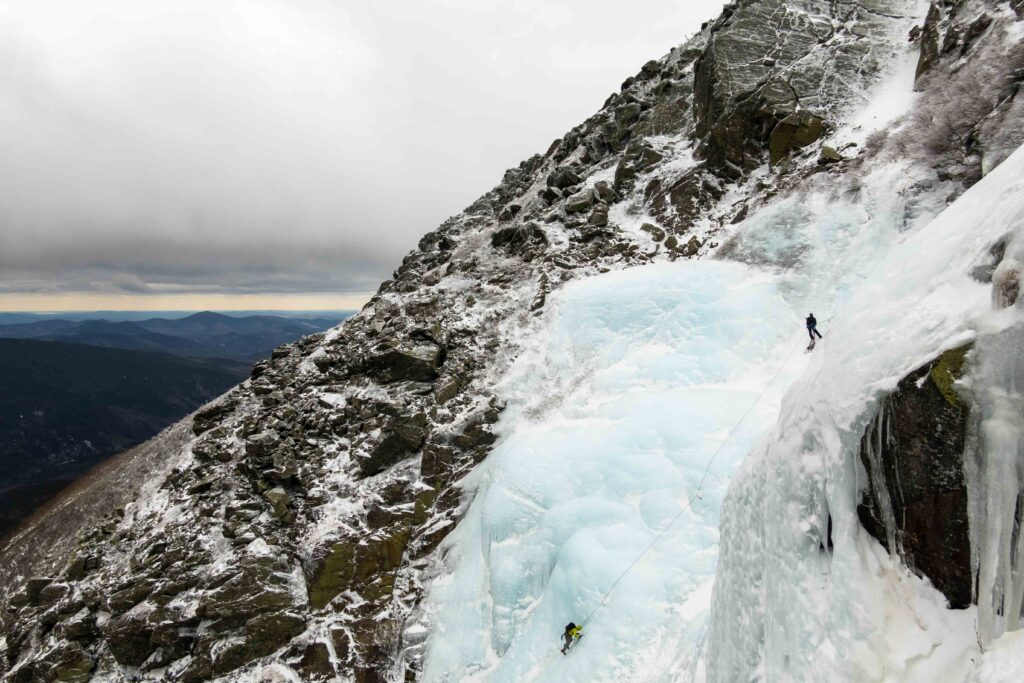
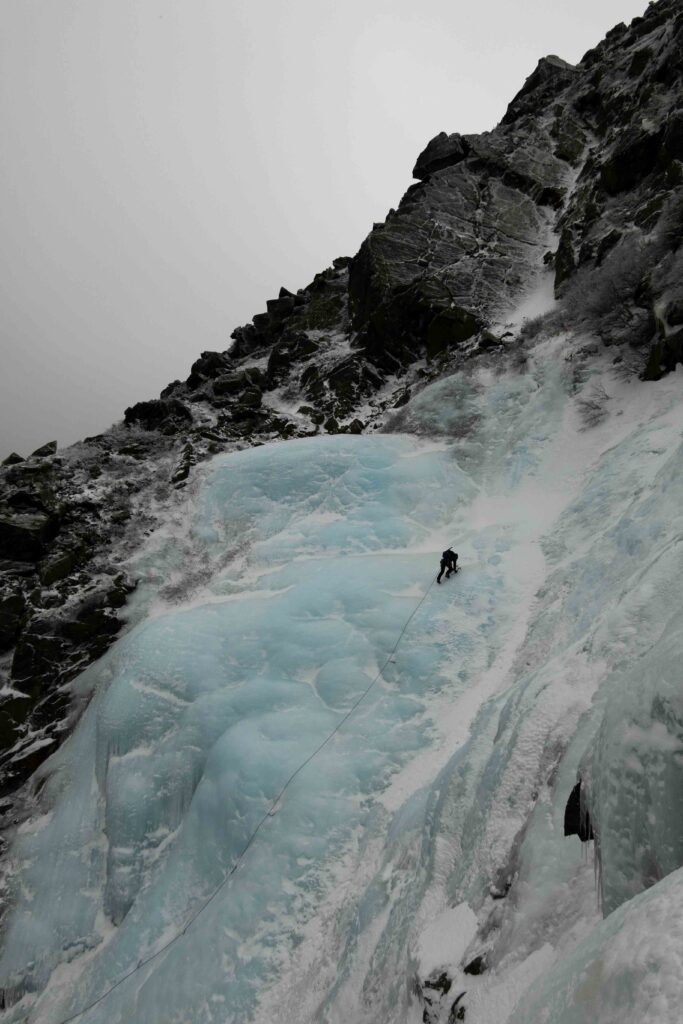
We also saw that we could’ve joined the main gully by doing a rising traverse, rather than going straight up from my belay. That must be the proper way to run this route.
With our double ropes, we could do a full-length rappel. I rapped first and arrived at the snow. At the same time, the clouds cleared to reveal sunny, blue skies. As Phillip rappelled, I took photos against this backdrop.
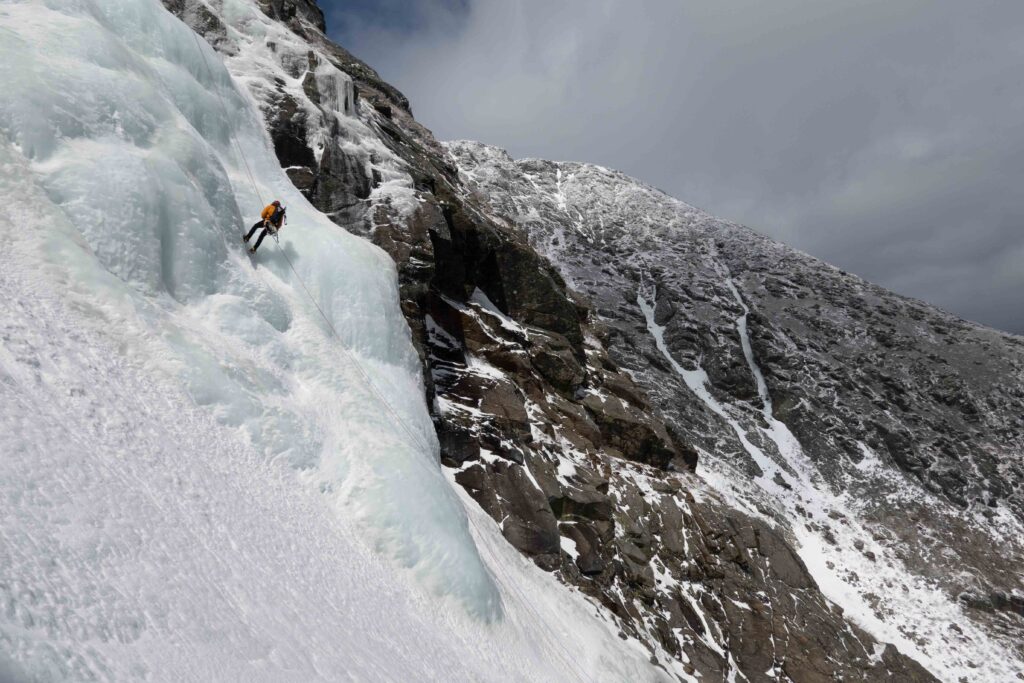
Now, we had the choice to climb more ice in regular O’Dell’s Gully. In the end, we decided to descend out of laziness. Phillip was a bit tired, and I was already more than satisfied from doing the harder of the two route choices. After checking the guidebook later, we found out this variation goes at WI3+ — which it felt like.
We descended steep snow until it eased off at the bottom of the gully. We decided to try glissading.
I took off my crampons and began an awkward glissade with my ice tool. The snow was hard and icy. I picked up a lot of speed. It wasn’t so much a glissade as it was a perpetual self-arrest while on my butt.
Phillip gave glissading a shot too but decided to abandon the idea and he walked down to meet me. This was good, because thanks to the awkward ice-tool glissade my rotator cuff annoyed me for the next few days. I likely sprained it a tad.
From here, we had a great view of the rest of the ravine. There were several climbers on Yale Gully. We first saw them an hour ago. Now, they were still in the same spot — not having moved. I zoomed in with my camera to take a look. It seems like someone is hurt, but they didn’t sound any alarms so I bet it was minor. Some falling ice must have cut someone up or something.
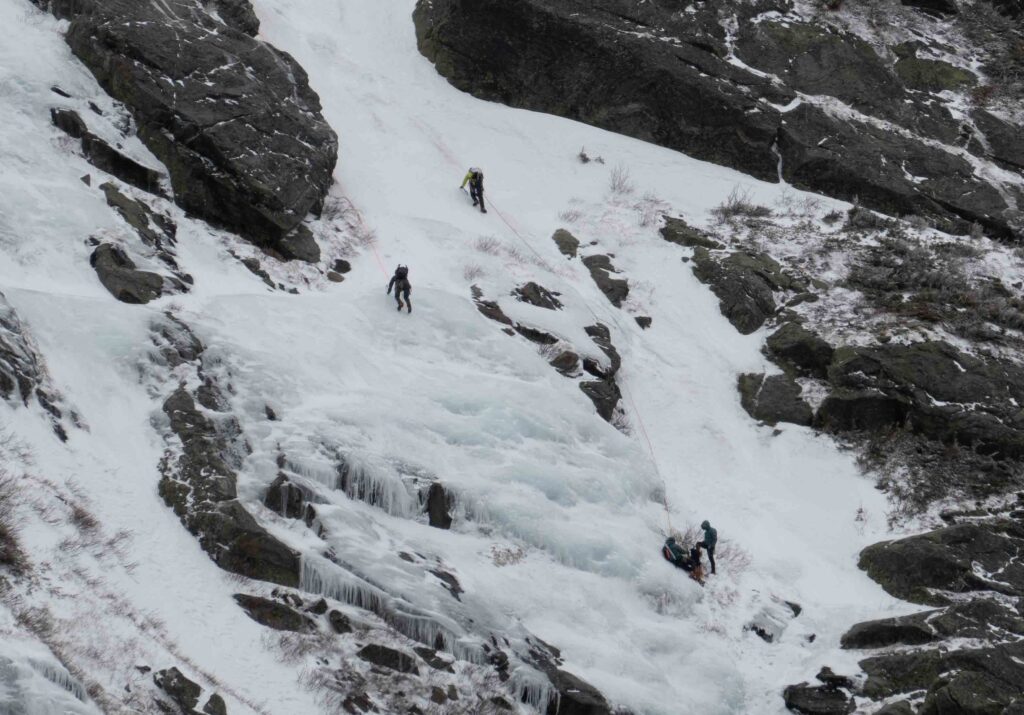
It was smooth sailing to the Huntington Ravine fire road. From there, an easy descent on the “hiker highway” would get us to our cars.
On the way back we stopped at the Harvard Cabin. For some reason, there was a comical amount of snow pickets by the entrance. Several were hanging on a hook, and a few were in a pile. Most of them were brand-new with an “MSR” label on them.
We found this hilarious. I’ve never seen so many pickets in a day on Mt. Washington before. Today wasn’t even crowded. I’ve seen fewer people with them on crevassed Cascadian glaciers in fact. Maybe the guides bring loads of them as default? Who knows.
We left the picket pile behind and continued downhill. We reached the car an hour later. I took off my sweaty mountain boots and changed into flip-flops. The feeling was absolute bliss. There’s nothing like taking boots and socks off at the end of the day.
On the drive back, we stopped for some food in North Conway. I also checked out IME’s gear consignment section. From there, I bought an ice screw roll so I could stop ripping up my backpack with exposed screws. I also found an absolute gem: A barely used Nemo Kunai 2 Mountaineering tent. I already owned this tent, but I destroyed it a few weeks earlier in a sudden 60+ mph storm. I wasn’t able to pitch it properly due to the conditions at that time, but it was absolutely bomber for the weight. There weren’t any new ones in stock, but here was a barely-used one at half the price. I snatched it up.
We reached Boston a few hours later. I unpacked my gear. Then, I walked a convenient 10 minutes to the university gym so I could shower, foam roll, and stretch. I walked back, cooked dinner, and went to sleep.
